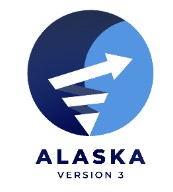When originally pondering the question for, “What is our next Alaska?”, many ideas rose to the surface — some of them better than others.
Initially, concepts from Agile Economic Development seemed most viable:
By moving past the traditional approach of focusing on only retaining existing businesses and attracting new ones from out of state, we could shift into organic business creation, where innovative ideas thrive. And from the eyes of entrepreneurial ecosystem developers, this showed obvious benefits.
But as time passed and more people got engaged with what was first called Next Alaska 3.0, things changed (as they always do).
The Facebook Group and LinkedIn Group were created, and the website began development under a new domain, “akv3.”
And just like that, Next Alaska 3.0 became Alaska Version 3.
But a minor rebranding won’t stand in the way of a major mission — one that’s still very much consistent with the general idea of “What’s next, Alaska?”

Alaska started as a subsistence economy, and grew into an extraction economy. What’s next for Alaska?
Our mission is to ask, “What’s next, Alaska?”
In the beginning, the question wasn’t, “What is our next Alaska?”
The first question was born from the pandemic response and confronting, “Why is investing in innovation so difficult?”
Participating in Assembly meetings and hearing from entrepreneurs about how the CARES Act doesn’t support startups—and how it could with just some restructuring—brought some very important and seemingly obvious topics to the surface: Startups are often left behind by government assistance.
To be given the answer of, “We’ll wait to see what happens with the budget,” was diminishing to innovative Alaskans statewide.
Investing in innovation has obvious benefits for communities at large including more agile markets, better job opportunities, and global market competitiveness.
As we’ve seen more of in the last decade, Alaska has a number of unique qualities it brings to the table: Diverse lived experiences, strong independent thinkers, and enough natural resources to drive an entire economy for nearly 300 years to name a few.
We all know an Alaskan who was raised here and left to go do amazing things, and we can’t blame them. The story is the same every time: There’s not enough growth in Alaska to feel like you’re making a real impact.
But what if we could change our economy so those people stayed in Alaska? If we moved past the constant budget-talk and moved into owning our own innovation?
It’s impossible to answer now, but the question is worth exploring.
And that’s exactly what Alaska Version 3 (AKV3) is here to do.
Our goal is to start the conversation — not provide the answer.
The steps to get from the here & now to the innovative future aren’t easy, but they are straightforward.
In order to adapt and thrive, we need to stop continuing the same conversation of budgets, restrictions, and waiting around for federal money. Obviously, COVID-19 took us all for a spin, and it’d be foolish to ignore the impact it’s had on Alaska.
But this conversation of budgets, PFDs, and how federal money presses on the happiness of us all are reiterated year-in and year-out. No matter who’s in office, no matter our economy, no matter the natural disasters, these conversations don’t end. They’re cyclic at best and regressive at worst.
Alaska V3 isn’t looking to break this cycle, but to move past it entirely.
More specifically, our goals are to create:
- More informed citizens
- Our own economy
- Conversations to bring to policymakers
And we’ll do that by:
- Empowering individuals to create the future they want
- Honoring the past to understand how we got here
- Engaging diverse thinking, experiences, and actions
Some of the most important voices and participants to this effort are those that have the most legitimate right to claim to be committed to the long term future of Alaska. Alaska Natives have the history and culture of people who have already been here for 10,000+ years, and should absolutely have a part to play—if not leading the discussion—about the next 10,000 years.
Once we move past the here and now, we can begin reflecting on what got us here—and what will push us forward.
But until we start that conversation, we will stay stuck in this vicious cycle.

Alaska is more than just Anchorage, Fairbanks, and Juneau. What does the future of ALL of Alaska look like to you?
So, what’s next, Alaska?
Answering this question is no easy task—that’s obvious. But the work we put in today will influence the future we see in our beautiful state, and relying on federal money, budgets, and policymakers to get us there doesn’t make much sense any longer.
Visions like this always overestimate what can be done in the short-term—but Alaska’s future is not tomorrow or next year. Alaska Version 3 looks to address the next 3, 30, and 300+ years—and we cannot overestimate what is possible in the long-term.
It was Alaska Natives who cared for this land first, and it was entrepreneurs and developers who leveraged the land second.
Will it be us advancing Alaska next, or will we allow policymakers outside of our communities to continue to make decisions for us?
How to get involved
For anybody interested in working with us, we are currently meeting regularly and would love to have you join the discussion.
Even if you’re not sure what that work might be, please add your name to the list below to receive updates on these meeting times, notes, and forward steps.

